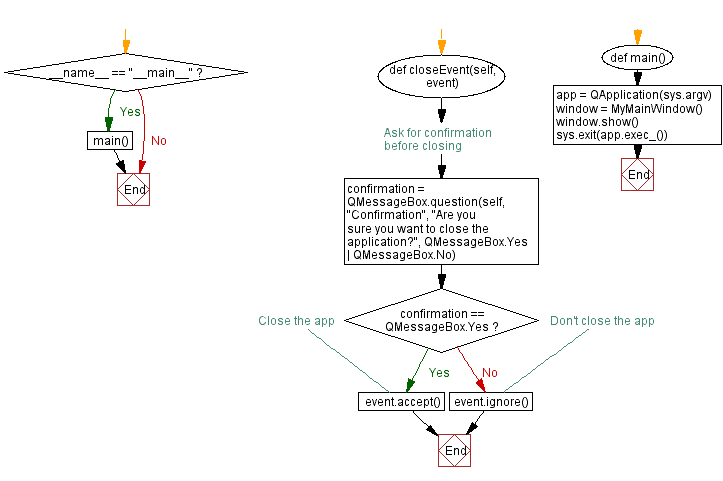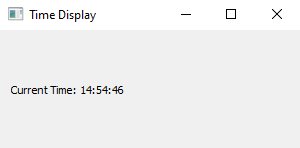Python PyQt time display
Write a Python program that creates an application with a window that displays the current time. Use the PyQt module.
From doc.qt.io:
QApplication Class: The QApplication class manages the GUI application's control flow and main settings.
QWidget Class: The QWidget class is the base class of all user interface objects.
QLabel Class: The QLabel widget provides a text or image display.
QVBoxLayout Class: The QVBoxLayout class lines up widgets vertically.
QTimer Class: The QTimer class provides repetitive and single-shot timers.
QTime Class: The QTime class provides clock time functions.
Sample Solution:
Python Code:
import sys
from PyQt5.QtWidgets import QApplication, QWidget, QLabel, QVBoxLayout
from PyQt5.QtCore import QTimer, QTime
class TimeDisplayApp(QWidget):
def __init__(self):
super().__init__()
self.setWindowTitle("Time Display")
self.setGeometry(100, 100, 300, 100) # (x, y, width, height)
layout = QVBoxLayout()
# Create a label for displaying the time
self.time_label = QLabel(self)
layout.addWidget(self.time_label)
self.setLayout(layout)
# Create a QTimer that updates the time label every second
self.timer = QTimer(self)
self.timer.timeout.connect(self.update_time)
self.timer.start(1000) # Update every 1000 milliseconds (1 second)
def update_time(self):
# Get the current time and set it on the label
current_time = QTime.currentTime().toString("hh:mm:ss")
self.time_label.setText(f"Current Time: {current_time}")
def main():
app = QApplication(sys.argv)
window = TimeDisplayApp()
window.show()
sys.exit(app.exec_())
if __name__ == "__main__":
main()
Explanation:
In the exercise above -
- Import the necessary modules from PyQt5.
- Create a custom "QWidget" class named "TimeDisplayApp" that builds the main application window.
- Inside the window, there's a label (self.time_label) for displaying the current time.
- Set up a QTimer (self.timer) that triggers the update_time slot function every second (1000 milliseconds).
- In the "update_time()" slot function, we get the current time and set it on the label. This function runs every second, so the label updates with the current time automatically.
- In the main function, we create the PyQt application, instantiate the TimeDisplayApp class, and show the main window.
Output:
Flowchart:

Go to:
Previous: Python PyQt close window confirmation.
Next: Python PyQt checkbox example.
Python Code Editor:
What is the difficulty level of this exercise?
Test your Programming skills with w3resource's quiz.

